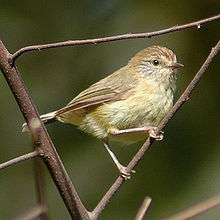Acanthiza
| Acanthiza | |
|---|---|
 | |
| Yellow thornbill | |
| Scientific classification | |
| Kingdom: | Animalia |
| Phylum: | Chordata |
| Class: | Aves |
| Order: | Passeriformes |
| Family: | Acanthizidae |
| Genus: | Acanthiza Vigors & Horsfield, 1827 |
| Species | |
|
13, see text. | |
Acanthiza is a genus of passeriform birds, mostly found in Australia but with one species (A. murina) restricted to New Guinea. These birds are commonly known as thornbills. They are not closely related to species in the hummingbird genus Chalcostigma which are also called thornbills.
They are found primarily in Australia and have a thin long beak. Colloquially the thornbill is sometimes referred to as a “tit” by locals, but in reality the Australian continent lacks any true tits, albeit Acanthiza species do show some similarities with tits in their behaviour. This is expressed in the fact that, like tits, Thornbills live in small groups foraging amidst trees and shrubs, and feed in a similar manner. Cooperative breeding is recorded from most species except the brown and Tasmanian thornbills.[1]
The habitat preferences of the group vary from dense forest to open saltbush and bluebush plains.
Acanthiza follow a very characteristic undulating path when flying. Their diet is formed essentially of little insects and plant lice that these birds glean from foliage. They are also exceptional acrobats that are easily able to stay head downward like tits do.
The nest of the Acanthiza is a large dome-shaped construction, completely enclosed except for a side hole, just like that of the long-tailed tit; however Acanthiza adds to it an additional room whose function is unknown. It is somewhat similar to the Aegithalidae in combining long incubation periods with highly synchronous hatching.[2] This combination, normally impossible due to intense competition for food,[3] occurs because parents and (usually) helpers can organise food supply in such a manner that sibling competition for food is virtually absent.[4]
The number of eggs usually ranges from two to four, and the incubation period is around twenty days with laying intervals of two days. The length of an adult bird is 8 to 10 centimetres (3.1 to 3.9 in).
Species
- Inland thornbill, Acanthiza apicalis
- Yellow-rumped thornbill, Acanthiza chrysorrhoa
- Tasmanian thornbill, Acanthiza ewingii
- Western thornbill, Acanthiza inornata
- Slender-billed thornbill, Acanthiza iredalei
- Mountain thornbill, Acanthiza katherina
- Striated thornbill, Acanthiza lineata
- New Guinea thornbill, Acanthiza murina
- Yellow thornbill, Acanthiza nana
- Brown thornbill, Acanthiza pusilla
- Buff-rumped thornbill, Acanthiza reguloides
- Slaty-backed thornbill, Acanthiza robustirostris
- Chestnut-rumped thornbill, Acanthiza uropygialis
References
- Del Hoyo, J.; Elliot, A. & Christie D. (editors). (2006). Handbook of the Birds of the World. Volume 12: Picathartes to Tits and Chickadees. Lynx Edicions. ISBN 978-84-96553-42-2
- ↑ Higging, P.J. and J.M. Peter; Handbook of Australian, New Zealand and Antarctic Birds, vol. 6: Pardalotes to Shrike-thrushes. ISBN 0-19-553762-9
- ↑ Ricklefs, R.E.; “Sibling competition, hatching asynchrony, incubation period, and lifespan in altricial birds”; in Power, Dennis M. (editor); Current Ornithology. Vol. 11. ISBN 9780306439902
- ↑ Losdat, Sylvain, Helfenstein, Fabrice, Gaude, Benoît and Richner, Heinz; “Effect of sibling competition and male carotenoid supply on offspring condition and oxidative stress”
- ↑ Ricklefs, Robert E.; “SIBLING COMPETITION AND THE EVOLUTION OF BROOD SIZE AND DEVELOPMENT RATE IN BIRDS”
External links
- Acanthiza fotos & videos on the Internet Bird Collection